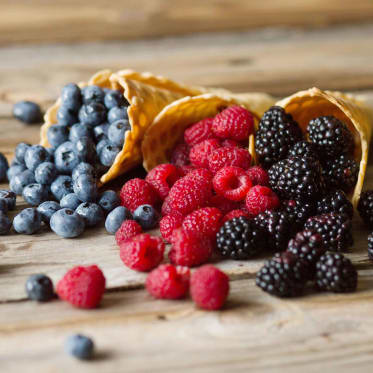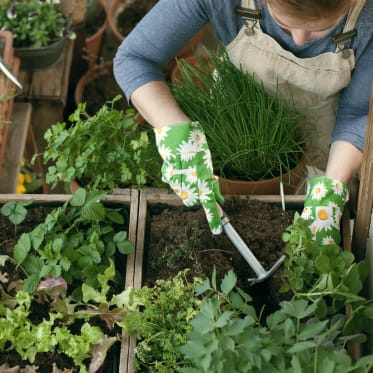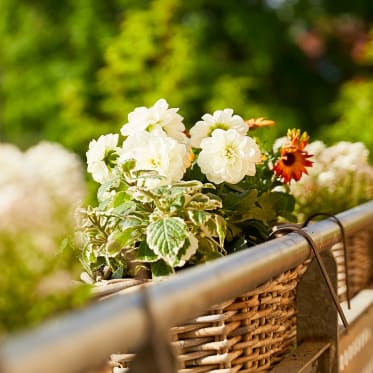Frequent search terms

- COMPO
- Guide
- Plant Care
- Herbs, fruits and vegetables
- Berry special: All you need to know about berries
Berry special: All you need to know about the superfruits
Not only do berries taste delicious, they are also true superfruits: They contain lots of vitamins, strengthen our immune system and sometimes even have anti-inflammatory properties. It comes as no surprise that the summer harvest is a highlight of the gardening year. Find out more about the different types of berry and what you should keep in mind when caring for them here.
Tasty berries for your garden
Sweet
Strawberries

With more than 1,000 varieties, strawberries vary greatly in shape, colour, size, taste, harvesting time and much more. Strawberries are perfect for those with a sweet tooth: With a water content of more than 90 per cent, the fruits are very low in calories and healthy – they contain lots of vitamin C, folic acid, iron and calcium. From a botanical standpoint, strawberries are actually not berries at all but rather aggregate fruits – the actual fruits of the strawberry plant are the yellow seeds on the surface.
Depending on when they start to bloom and ripen, strawberries differ in very early and very late varieties. When growing strawberries, it is also important to distinguish between the varieties that bear fruit once and those that do so twice. Varieties that bear fruit once, such as 'Bogota, 'Elvira' and 'Havelland', only develop their flowers in the spring. Whereas varieties that bear fruit twice or several times, e.g. 'Machern' and 'Ostara', also bloom during the long summer days. If you would like to pick your strawberries over a longer period, you should grow a mixture of different varieties. The following rule applies: The earlier you plant the fruits the better. The flowers are formed between August and October for the following year. If you plant later, the harvest will be smaller. It is best to keep a distance of about 30 cm between the plants.
Sour
Currants
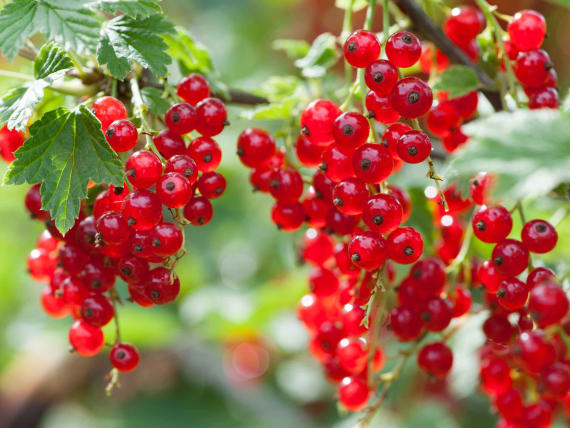
Currants belong to the Grossulariaceae family and are extremely resilient. The bright red berries are quite sour but taste delicious as a jam or on cakes. They are also full of vitamin C. Black currants are even healthier and more aromatic: They improve the permeability of the blood vessels and can thus prevent heart attacks. There are also colourless sweet varieties, like 'Primus' or 'White Versailles', for berry lovers who like to eat the fruits raw.
Currants have few requirements when it comes to location and can cope with both shaded and semi-shaded spots. But the berries develop their full aroma when they ripen in the sun and at least two different varieties are planted next to one another.
Fresh
Raspberries

Raspberries are divided into two groups of varieties: summer and autumn raspberries.
The upside of autumn raspberries is that they ripen so late in the year that you needn't worry about raspberry beetles. On the other hand, summer varieties have a better yield and a higher fruit quality.
As the raspberry bush can grow up to two metres tall, it is a good idea to put a climbing aid in the form of a trellis in the bed. Place the individual plants along the trellis in the bed with space of about half a metre between them. The best time to plant raspberries is the beginning of October. Raspberries prefer the sun, but also thrive in semi-shaded spots. It is important to protect them from the wind. The plants need a nutrient-rich, loose soil; raspberries can't withstand waterlogging at all.
Fruity
Blackberries

Blackberries owe their name to the thorns on their vines that they use to help them climb. They have been traditionally referred to as bramble. The term blackberry originates from the Old English word 'blæc-berie'.
Blackberries develop best in sunny spots – because of their vines, a building wall facing south is an ideal place to put the plant. Growing blackberries in trellises is another alternative. Plant them about 5 cm deeper than they sit in the pot to promote the formation of new twigs. Then prune the existing twigs so that they are about 30 cm long. The soil should be rich in humus, highly permeable and not too light. Less limey locations with pH values between 5.5 and 6.5 are advantageous.
The blackberry is a biennial plant. This means that the young twigs grow in the first year and the side shoots grow from the young twigs in the second year. If enough young twigs have formed, you can prune the twigs from the end of May until the beginning of June. Leave about six young twig shoots per plant – these will bear the fruits the following year. From October onwards, two-year-old twigs close to the ground should be removed.
Not all berries are equal
From a botanical standpoint, are bananas, dates, kiwis or tomatoes, peppers and aubergines also berries? A berry is a fruit that falls from the plant in a closed state and does not open when it is ripe.
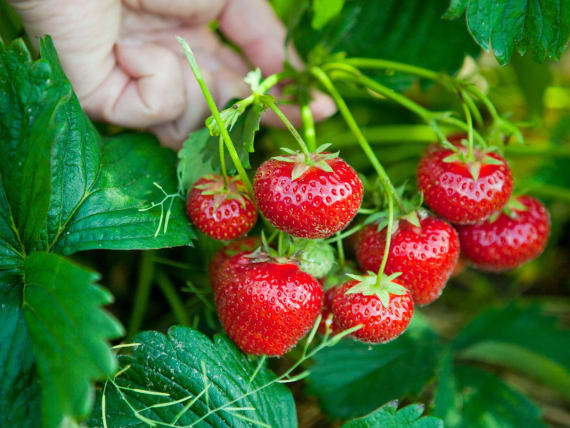
Harvesting aromatic berries: Succeed with these care tips
If you decide to purchase resilient varieties and make sure to provide the right care, you are best placed to have a successful berry harvest. Good soil, enough nutrients and regular watering are key.
The best soil for berries
Berries generally love loose, humus-rich soils. Use a high-quality soil with ingredients tailored to the needs of the berries for planting. Then water thoroughly. But beware: Make sure that there is no risk of waterlogging. Loamy soil can be enriched with compost, leaves or sand. The pH value of the soil should ideally be slightly acidic and between 5.5 and 6.0.
The ideal nutrient supply
The plants only develop abundant sweet fruits if they are supplied with enough nutrients. Once the first shoots are showing, you can stimulate growth with fertiliser. A slow-release fertiliser is a good idea for those who only wish to fertilise once per season.
Berry bushes also need thorough care after the harvest. To give your plants a helping hand, first remove any weeds below the bushes, then loosen the soil with a rake and incorporate a berry fertiliser. Then mulch with grass cuttings or straw. During the main growth period, place straw around your strawberry plants – this will protect the fruits from dirt and rot. The following applies to currants: As they have very shallow roots, it is better not to rake too deeply!
When you can pick berries
The harvesting time for berries depends on the chosen variety (early-blooming, late-blooming, everbearing, etc.) and the intended use. The more sun the fruits get and the longer you wait, the sweeter and more aromatic they become. With that in mind, it is best to pick berries for eating as late as possible, while those for marmalades and jams can be harvested before they are fully ripe. Strawberries can often be harvested in June. Currants bear fruit a little later and are ready to be picked from the end of June until the beginning of August. From the end of July/beginning of August until mid-October, you can pick raspberries and blackberries.
Pruning berries: How to keep berries in a fruity mood
Immediately after the harvest or at the end of the winter, older shoots should be pruned so that the younger shoots can develop better – they ultimately deliver the harvest. The three- to four-year-old fruit branches are trimmed and the young, strong ground shoots tightened up. Weak young shoots and side shoots that are too thick are also removed. The shoots of raspberries and blackberries only come through the year before; the removed two-year-old shoots are cut to the ground after the harvest.

Pests and fungal diseases affecting strawberries
Snails have a special penchant for strawberries. They descend upon the red fruits and other vegetables at night and can destroy entire harvests. Special products help to ward off snails. Besides a snail barrier made from shell limestone, our range features different granulates with an active ingredient to combat slugs.
Characteristic fungal diseases affecting strawberries are common spot of strawberry and strawberry leaf scorch. Large round spots, measuring about 1-4 mm, appear on the leaves during the harvest. Common spot of strawberry can be identified by the white spots with red edges. In cases of strawberry leaf scorch, the spots are a red-brown colour. The more severe the infestation, the more the spots merge. A fungicide, e.g. in the form of a ready-to-use spray or concentrate, can help to combat the disease.
Pests and fungal diseases affecting raspberries
A raspberry beetle infestation is a common disease affecting summer raspberries. The beetles mainly look for food on fruit plants in May after hibernating in winter. After fertilisation, females lay their eggs in the flowers of the raspberry. The hatched larvae feed off the ripening fruits, reducing the harvest in affected raspberry plants.
A common fungal disease affecting raspberries is raspberry rust. It can be identified by the greenish to yellow spots on the upper side of the leaf. On the underside of the leaf, they are bright orange and turn brown to black over time. If the shrubs are severely infested, the leaves are prematurely shed by the raspberry plant. In this case, a remedy against fungal infections can be used to stop the spread and prevent new infestations.
More on growing fruits and vegetables in your garden

